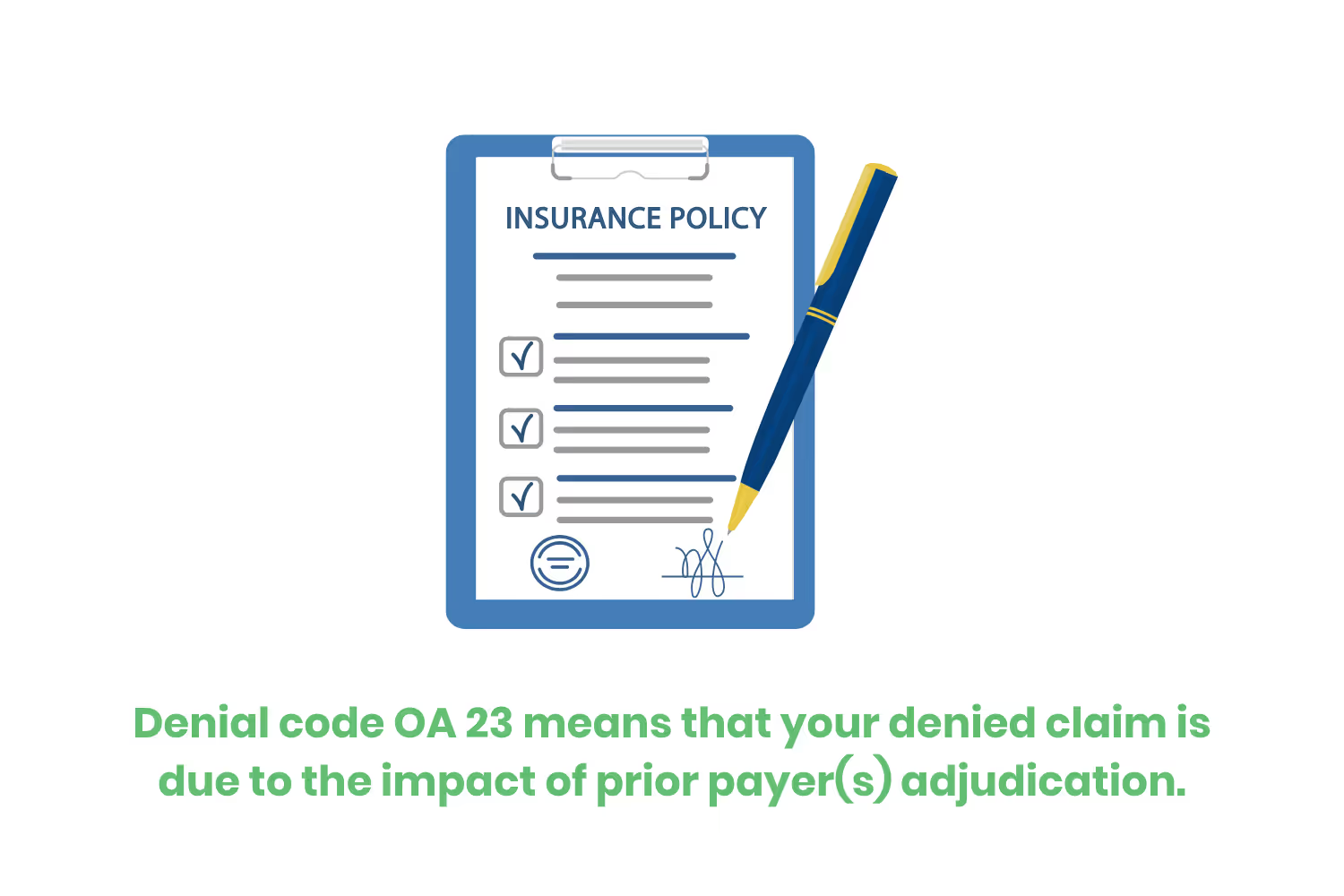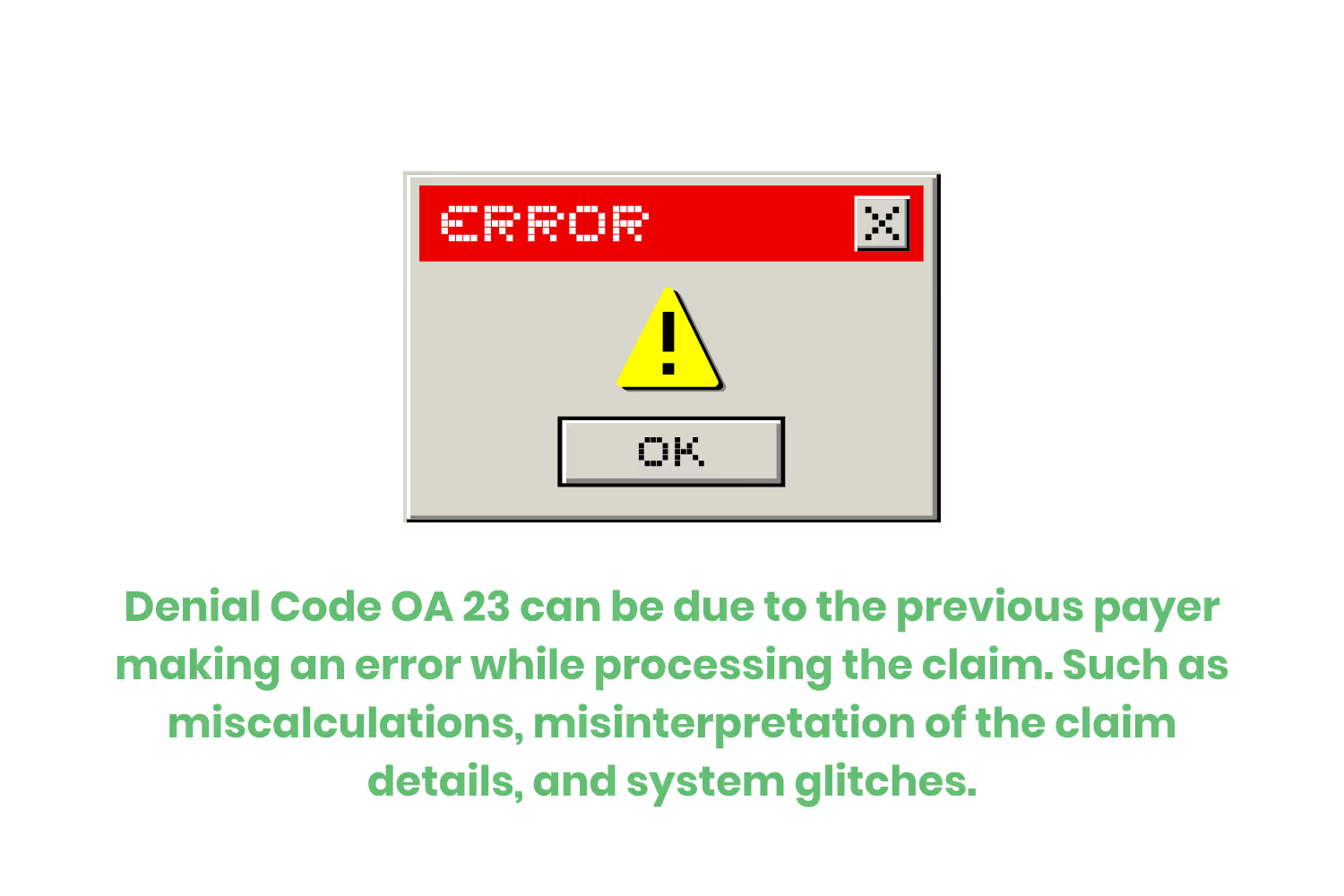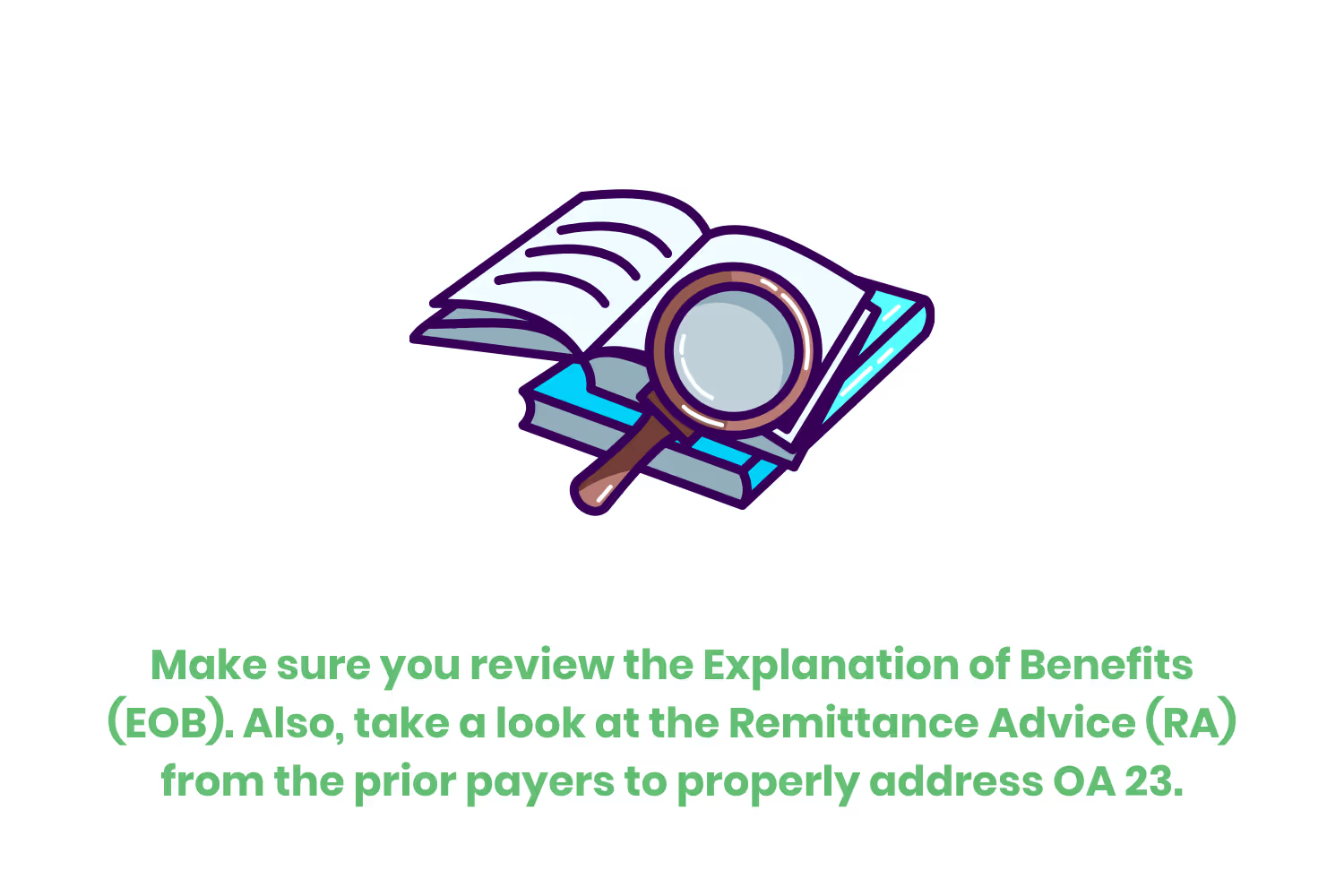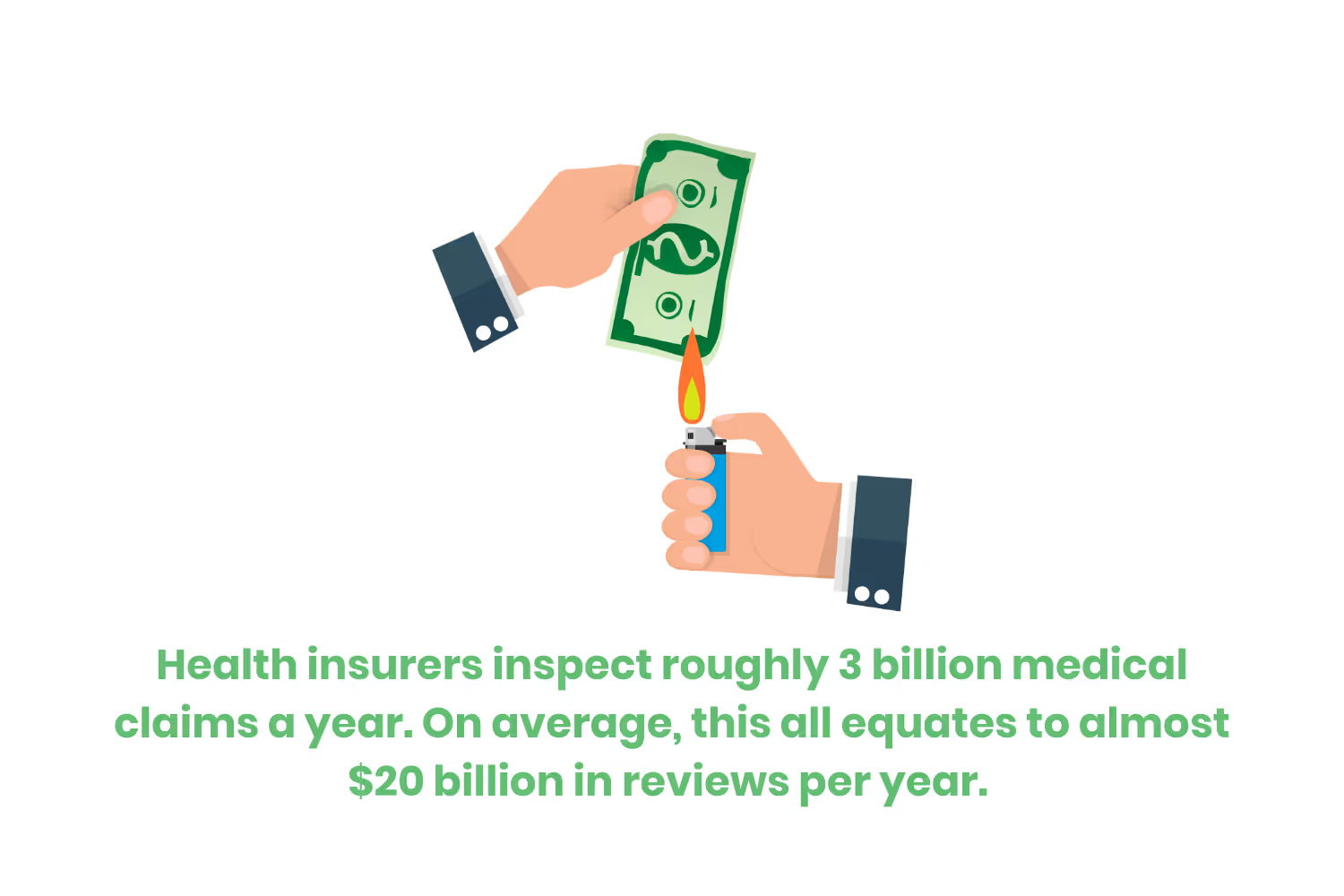Denial Code OA 23: An Ultimate Guide
Making it easier for them to recognize any errors that might flag a denial. One of these common codes is denial code OA 23. So let’s walk through what this denial means, what causes it, and how to address/prevent it.

According to a Premier, Inc. National Survey, private payers initially deny 15% of medical claims. This data comes from reports from hospitals, health systems, and post-acute care providers. These hospitals and health systems fought these denials at an average of $43.84 per claim.
This number may not seem like a lot, but factor in the number of claim denials healthcare organizations face in a year. For example, health insurers inspect roughly 3 billion medical claims a year. On average, this all equates to almost $20 billion in reviews per year.
This doesn’t cover the clinical labor cost needed to handle these claim denials. Frequent denials cost organizations in many ways which includes time, too. More time spent on arguing back and forth with insurance companies means less time to interact with current patients. Allowing other administrative tasks, such as following up on outstanding patient balances, to slip through the cracks. Causing more financial stress.

While this all seems a bit “doom and gloom”, there is a way to combat these pesky denials. And it’s actually quite simple: educate your staff! That’s right, preventing a claim denial is way cheaper and less of a hassle than having to work one.
Keeping your team up to date with some of the more common denials can help them stay vigilant. Making it easier for them to recognize any errors that might flag a denial. One of these common codes is denial code OA 23. So let’s walk through what this denial means, what causes it, and how to address/prevent it.
What is Denial Code OA 23?
When you receive denial code 23, this means that your denied claim is due to the impact of prior payer(s) adjudication. This includes payments and/or adjustments. You can find this information on the electronic remittance advice (ERA) and explanation of benefits (EOB) sent back by the payer.
You will often see this denial code coupled with CAGC (Claim Adjustment Group Code) OA (Other Adjustment), which indicates an administrative adjustment. This group code is appropriate when neither CO (contractual obligation) or PR (patient responsibility) apply.

As a whole, when you refer to denial code OA 23, you are referring to a CARC (Claim Adjustment Reason Code). These codes consist of two letters plus a numeric value. Sometimes with an additional letter in front of that numeric value. So, now that we understand what this code means a little better, you might be wondering what exactly causes it.
Causes of Denial Code OA 23
There are many reasons you might receive denial code OA 23. However, there are a few that are more common than others. First up, incorrect payment or adjustment by a prior payer. This is what it sounds like. A previous payer, like an insurance company or government payer, makes an error while processing the claim.
Errors can include be due to:
- Miscalculations.
- Misinterpretation of the claim details.
- System glitches.
Another cause might be inadequate documentation. Without complete and thorough medical documentation submitted with a claim, there is a chance you might receive denial code OA 23. Payers rely heavily on this supporting documentation to verify the accuracy of services billed.

They also rely on the accuracy of the medical coding itself, which brings us to the next cause: incorrect coding. I know this one is a bit obvious. I mean, it’s the main cause of all kinds of denial codes when it comes down to it! That’s why when you are coding, you need to make sure you are noting the right procedures and diagnosis codes. A few more common reasons for this type of claim denial include the following:
- Non-covered services.
- Coordination of benefits (COB) issues.
- Timely filing limits exceeded.
- Duplicate claims.
- Contractual agreements.
So why do we put so much emphasis on what causes this claim denial? It’s because addressing and fixing the denial is something like a puzzle. You need all the pieces of the puzzle to see the full picture. By knowing what caused the problem, you can better equip yourself to take the necessary steps to fix it.
Addressing Denial Code OA 23
There are a few steps recommended when it comes to addressing denial code OA 23. Today, we are going to cover them all, from start to finish. First, make sure you review the EOB.
Also, take a look at the Remittance Advice (RA) from the prior payers, too. Consulting both documents will help you to understand the details of the adjudication process.
Next, compare the prior payer’s payments and adjustments with the expected reimbursement. Use contracted rates and fee scales to base the expected reimbursement on.
Then identify any discrepancies or underpayments. There could be errors caused by the previous adjudication.

Make sure to gather the necessary documentation. Documentation could be copies of claims and medical records, among other things. This information is vital for the prior payer’s reconsideration of the claim. If you need to, you can contact the prior payer directly. They can offer further clarification on how to handle denial code OA 23, and what information they will need from you.
Depending on what prior payer you work with, follow their specific process for submitting your reconsideration request. Different payers have different procedures for appealing a claim denial, so pay attention to what forms and documentation you may need to include.
Record all forms of communication you keep with the prior payer and monitor the status of your appeal. Keep a log consisting of the dates, times, and names of individuals spoken to. Follow up with the prior payer when necessary to ensure a timely mitigation.
Finally, if the prior payer still upholds the denial, you can try the following:
- Look over the documentation to double-check, then resubmit the appeal.
- Take the issue to a higher level within the prior payer’s organization.
- Seek assistance from a healthcare revenue cycle management specialist.
Preventing Denial Code OA 23
Understanding what causes the problem not only helps you to address it but also helps you to mitigate future occurrences. Reducing your denial rate can only bring positive results when it comes to your revenue cycle management process. It means collecting your payments faster and reducing the workload on your billing and administration team.
There are a few proactive strategies to utilize here. One of them is to always verify a patient’s eligibility and insurance coverage before delivering services. Knowing these benefits helps to avoid all sorts of claim denials by ensuring clear communication between the patient, the payer, and you. In the case of denial code OA 23, there may also be prior adjudications that verification can highlight.
Following the lists of causes, make sure to accurately document medical records. They should be clear, complete, and readily support why certain procedures get rendered. This promotes validation of medically necessary services and helps promote accurate coding.

When it comes to reducing denial code OA 23 rates, making sure you submit your claims in a timely fashion is essential. Not doing so can lead to an influx of denials due to prior payer adjudication. Keeping your billing and coding processes streamlined helps to regulate a timely submission system.
Timely submission of claims is equally important in reducing the likelihood of code 23 issues. Submit claims promptly after providing services to avoid delays that could lead to denials based on prior payer adjudication. Establishing efficient workflows for claim submission ensures that the claims process is within the payer's required timeframes, reducing the chances of complications. Make sure to stay vigilant of different payers’ rules and regulations on submission timeframes.
Check out these additional strategies when it comes to preventing denial code OA 23:
- Following up on unpaid claims.
- Follow appeal processes carefully.
- Stay up to date with payer policies.
Conclusion
Denial code OA 23 can be a challenge. However, by understanding the causes and taking the best course of action to implement prevention strategies, you can reduce the rate of this denial code.
By constantly evaluating and improving your revenue cycle processes, you can expect to run into fewer denials related to prior payer adjudication. And fortify a smoother claim submission process. Utilize technology and automation for a streamlined process, reducing the risk of human error on top of saving time and money.
Emphasize your product's unique features or benefits to differentiate it from competitors
In nec dictum adipiscing pharetra enim etiam scelerisque dolor purus ipsum egestas cursus vulputate arcu egestas ut eu sed mollis consectetur mattis pharetra curabitur et maecenas in mattis fames consectetur ipsum quis risus mauris aliquam ornare nisl purus at ipsum nulla accumsan consectetur vestibulum suspendisse aliquam condimentum scelerisque lacinia pellentesque vestibulum condimentum turpis ligula pharetra dictum sapien facilisis sapien at sagittis et cursus congue.
- Pharetra curabitur et maecenas in mattis fames consectetur ipsum quis risus.
- Justo urna nisi auctor consequat consectetur dolor lectus blandit.
- Eget egestas volutpat lacinia vestibulum vitae mattis hendrerit.
- Ornare elit odio tellus orci bibendum dictum id sem congue enim amet diam.
Incorporate statistics or specific numbers to highlight the effectiveness or popularity of your offering
Convallis pellentesque ullamcorper sapien sed tristique fermentum proin amet quam tincidunt feugiat vitae neque quisque odio ut pellentesque ac mauris eget lectus. Pretium arcu turpis lacus sapien sit at eu sapien duis magna nunc nibh nam non ut nibh ultrices ultrices elementum egestas enim nisl sed cursus pellentesque sit dignissim enim euismod sit et convallis sed pelis viverra quam at nisl sit pharetra enim nisl nec vestibulum posuere in volutpat sed blandit neque risus.

Use time-sensitive language to encourage immediate action, such as "Limited Time Offer
Feugiat vitae neque quisque odio ut pellentesque ac mauris eget lectus. Pretium arcu turpis lacus sapien sit at eu sapien duis magna nunc nibh nam non ut nibh ultrices ultrices elementum egestas enim nisl sed cursus pellentesque sit dignissim enim euismod sit et convallis sed pelis viverra quam at nisl sit pharetra enim nisl nec vestibulum posuere in volutpat sed blandit neque risus.
- Pharetra curabitur et maecenas in mattis fames consectetur ipsum quis risus.
- Justo urna nisi auctor consequat consectetur dolor lectus blandit.
- Eget egestas volutpat lacinia vestibulum vitae mattis hendrerit.
- Ornare elit odio tellus orci bibendum dictum id sem congue enim amet diam.
Address customer pain points directly by showing how your product solves their problems
Feugiat vitae neque quisque odio ut pellentesque ac mauris eget lectus. Pretium arcu turpis lacus sapien sit at eu sapien duis magna nunc nibh nam non ut nibh ultrices ultrices elementum egestas enim nisl sed cursus pellentesque sit dignissim enim euismod sit et convallis sed pelis viverra quam at nisl sit pharetra enim nisl nec vestibulum posuere in volutpat sed blandit neque risus.
Vel etiam vel amet aenean eget in habitasse nunc duis tellus sem turpis risus aliquam ac volutpat tellus eu faucibus ullamcorper.
Tailor titles to your ideal customer segment using phrases like "Designed for Busy Professionals
Sed pretium id nibh id sit felis vitae volutpat volutpat adipiscing at sodales neque lectus mi phasellus commodo at elit suspendisse ornare faucibus lectus purus viverra in nec aliquet commodo et sed sed nisi tempor mi pellentesque arcu viverra pretium duis enim vulputate dignissim etiam ultrices vitae neque urna proin nibh diam turpis augue lacus.



![[ANSWERED] What is a Long-Term Care (LTC) Pharmacy](https://cdn.prod.website-files.com/67e2b8210878abcba6f91ae6/68d687806a075a1cf64659b0_WhatisLongTermCarePharmacy_925.avif)
